Assimilation of Nanoparticles of SiC, ZrC, and WC with Polyaryletherketone for Performance Augmentation of Adhesives
Abstract
1. Introduction
2. Experimental
2.1. Materials
2.2. Preparation of Nano-Mixtures
2.3. Development of Nanocomposite (NC) Sheets and LSS Joints
- NC sheets
- Lap shear joints
3. Characterization
3.1. Physical Properties
3.2. Dispersion by FE-SEM
3.3. Surface-Free Energy Measurements on NC Sheets
3.4. X-ray Diffraction Studies
3.5. Thermogravimetric Analysis (TGA)
3.6. Thermal Conductivity
3.7. Dynamic Mechanical Analysis
3.8. Tensile Properties
3.9. Lap Shear Strength (LSS)
3.10. Failure Analysis
4. Results and Discussion
4.1. Physical Properties
4.2. Dispersion by FE-SEM
4.3. Surface-Free Energy Measurements on NC Sheets
4.4. X-ray Diffraction Studies
4.5. Thermogravimetric Analysis
4.6. Thermal Conductivity
4.7. Dynamic Mechanical Analysis
4.8. Tensile Properties
The Extent of Interaction Based on Theoretical Modeling
4.9. Lap Shear Strength (LSS)
4.10. Failure Analysis
5. Conclusions
- Surface free energy;
- Tensile strength of NCs;
- Dispersion of NPs;
- Crystallinity of NCs;
- Density of NPs.
Author Contributions
Funding
Data Availability Statement
Acknowledgments
Conflicts of Interest
References
- Chen, C.; Xue, Y.; Li, Z.; Wen, Y.; Li, X.; Wu, F.; Li, X.; Shi, D.; Xue, Z.; Xie, X. Construction of 3D boron nitride nanosheets/silver networks in epoxy-based composites with high thermal conductivity via in-situ sintering of silver nanoparticles. Chem. Eng. J. 2019, 369, 1150–1160. [Google Scholar] [CrossRef]
- Jouyandeh, M.; Tikhani, F.; Hampp, N.; Yazdi, D.A.; Zarrintaj, P.; Ganjali, M.R.; Saeb, M.R. Highly curable self-healing vitrimer-like cellulose-modified halloysite nanotube/epoxy nanocomposite coatings. Chem. Eng. J. 2020, 396, 125196. [Google Scholar] [CrossRef]
- Sun, Z.; Li, J.; Yu, M.; Kathaperumal, M.; Wong, C.-P. A review of the thermal conductivity of silver-epoxy nanocomposites as encapsulation material for packaging applications. Chem. Eng. J. 2022, 446, 137319. [Google Scholar] [CrossRef]
- Tabish, M.; Zhao, J.; Kumar, A.; Yan, J.; Wang, J.; Shi, F.; Zhang, J.; Peng, L.; Mushtaq, M.A.; Yasin, G. Developing epoxy-based anti-corrosion functional nanocomposite coating with CaFe-Tolyl-triazole layered double hydroxide@g-C3N4 as nanofillers on Q235 steel substrate against NaCl corrosive environment. Chem. Eng. J. 2022, 450, 137624. [Google Scholar] [CrossRef]
- Marathe, U.; Chalana, A.; Bijwe, J. Performance Augmentation of Epoxy Adhesives with TiN Nanoparticles. ACS Omega 2022, 7, 4150–4157. [Google Scholar] [CrossRef]
- Marathe, U.; Padhan, M.; Bijwe, J. Various attributes controlling the performance of nano-composites and adhesives of TiC-PAEK. Compos. Sci. Technol. 2021, 214, 108969. [Google Scholar] [CrossRef]
- Gültekin, K.; Akpinar, S.; Gürses, A.; Eroglu, Z.; Cam, S.; Akbulut, H.; Keskin, Z.; Ozel, A. The effects of graphene nanostructure reinforcement on the adhesive method and the graphene reinforcement ratio on the failure load in adhesively bonded joints. Compos. Part B Eng. 2016, 98, 362–369. [Google Scholar] [CrossRef]
- Akpinar, I.A.; Gültekin, K.; Akpinar, S.; Akbulut, H.; Ozel, A. Experimental analysis on the single-lap joints bonded by a nanocomposite adhesives which obtained by adding nanostructures. Compos. Part B Eng. 2017, 110, 420–428. [Google Scholar] [CrossRef]
- Joy, A.; Varughese, S.; Shanmugam, S.; Haridoss, P. Multiwalled Carbon Nanotube Reinforced Epoxy Nanocomposites for Vibration Damping. ACS Appl. Nano Mater. 2019, 2, 736–743. [Google Scholar] [CrossRef]
- Quiles-Díaz, S.; Martínez-Rubí, Y.; Guan, J.; Kim, K.S.; Couillard, M.; Salavagione, H.J.; Gómez-Fatou, M.A.; Simard, B. Enhanced Thermal Conductivity in Polymer Nanocomposites via Covalent Functionalization of Boron Nitride Nanotubes with Short Polyethylene Chains for Heat-Transfer Applications. ACS Appl. Nano Mater. 2018, 2, 440–451. [Google Scholar] [CrossRef]
- Wang, W.; Li, Z.; Prestat, E.; Hashimoto, T.; Guan, J.; Kim, K.S.; Kingston, C.T.; Simard, B.; Young, R.J. Reinforcement of Polymer-Based Nanocomposites by Thermally Conductive and Electrically Insulating Boron Nitride Nanotubes. ACS Appl. Nano Mater. 2019, 3, 364–374. [Google Scholar] [CrossRef]
- Das, S.; Halder, S.; Sinha, A.; Imam, M.A.; Khan, N.I. Assessing Nanoscratch Behavior of Epoxy Nanocomposite Toughened with Silanized Fullerene. ACS Appl. Nano Mater. 2018, 1, 3653–3662. [Google Scholar] [CrossRef]
- Díez-Pascual, A.M.; Naffakh, M.; Marco, C.; Ellis, G.; Gómez-Fatou, M.A. High-performance nanocomposites based on polyetherketones. Prog. Mater. Sci. 2012, 57, 1106–1190. [Google Scholar] [CrossRef]
- Marathe, U.N.; Bijwe, J. High performance polymer composites—Influence of processing technique on the fiber length and performance properties. Wear 2020, 446–447, 203189. [Google Scholar] [CrossRef]
- Panda, J.N.; Bijwe, J.; Pandey, R.K. Attaining high tribo-performance of PAEK composites by selecting right combination of solid lubricants in right proportions. Compos. Sci. Technol. 2017, 144, 139–150. [Google Scholar] [CrossRef]
- Bijwe, J.; Kumar, K.; Panda, J.N.; Parida, T.; Trivedi, P. Design and development of high performance tribo-composites based on synergism in two solid lubricants. Compos. Part B Eng. 2016, 94, 399–410. [Google Scholar] [CrossRef]
- Kadiyala, A.K.; Bijwe, J. Investigations on performance and failure mechanisms of high temperature thermoplastic polymers as adhesives. Int. J. Adhes. Adhes. 2016, 70, 90–101. [Google Scholar] [CrossRef]
- Kadiyala, A.K.; Bijwe, J. Poly (ether ether ketone)—Silicon carbide composite adhesives for elevated temperature applications of stainless steel joints. Compos. Sci. Technol. 2018, 155, 177–188. [Google Scholar] [CrossRef]
- Kumar, K.A.; Bijwe, J.; Kalappa, P. High temperature performance of composite adhesives based on PEEK and boron carbide particles. Polym. Compos. 2018, 40, 2473–2481. [Google Scholar] [CrossRef]
- Kadiyala, A.K.; Sharma, M.; Bijwe, J. Exploration of thermoplastic polyimide as high temperature adhesive and understanding the interfacial chemistry using XPS, ToF-SIMS and Raman spectroscopy. Mater. Des. 2016, 109, 622–633. [Google Scholar] [CrossRef]
- Kadiyala, A.K.; Bijwe, J.; Kalappa, P. Investigations on influence of nano and micron sized particles of SiC on performance properties of PEEK coatings. Surf. Coatings Technol. 2018, 334, 124–133. [Google Scholar] [CrossRef]
- Available online: https://www.nanoamor.com/home (accessed on 15 February 2023).
- Available online: https://www.nanoshel.com/ (accessed on 15 February 2023).
- Mallick, P.K. Fiber-Reinforced Composites: Materials, Manufacturing, and Design, 3rd ed.; CRC Press: Boca Raton, FL, USA, 2007. [Google Scholar]
- Kochetov, R.; Korobko, A.V.; Andritsch, T.; Morshuis, P.H.F.; Picken, S.J.; Smit, J.J. Modelling of the thermal conductivity in polymer nanocomposites and the impact of the interface between filler and matrix. J. Phys. D Appl. Phys. 2011, 44, 395401. [Google Scholar] [CrossRef]
- Zhu, C.-Y.; Yang, W.-X.; Xu, H.-B.; Ding, B.; Gong, L.; Li, Z.-Y. A general effective thermal conductivity model for composites reinforced by non-contact spherical particles. Int. J. Therm. Sci. 2021, 168, 107088. [Google Scholar] [CrossRef]
- Piggott, M.R.; Leidner, J. Misconceptions about filled polymers. J. Appl. Polym. Sci. 1974, 18, 1619–1623. [Google Scholar] [CrossRef]
- Nicolaiso, L.; Narkis, M. Stress-Strain Behavior of Styrene-Acrylonitrile / Glass Bead Composites in the Glassy Region. Polym. Eng. Sci. 1971, 11, 194–199. [Google Scholar] [CrossRef]
- Zare, Y. New models for yield strength of polymer/clay nanocomposites. Compos. Part B Eng. 2015, 73, 111–117. [Google Scholar] [CrossRef]
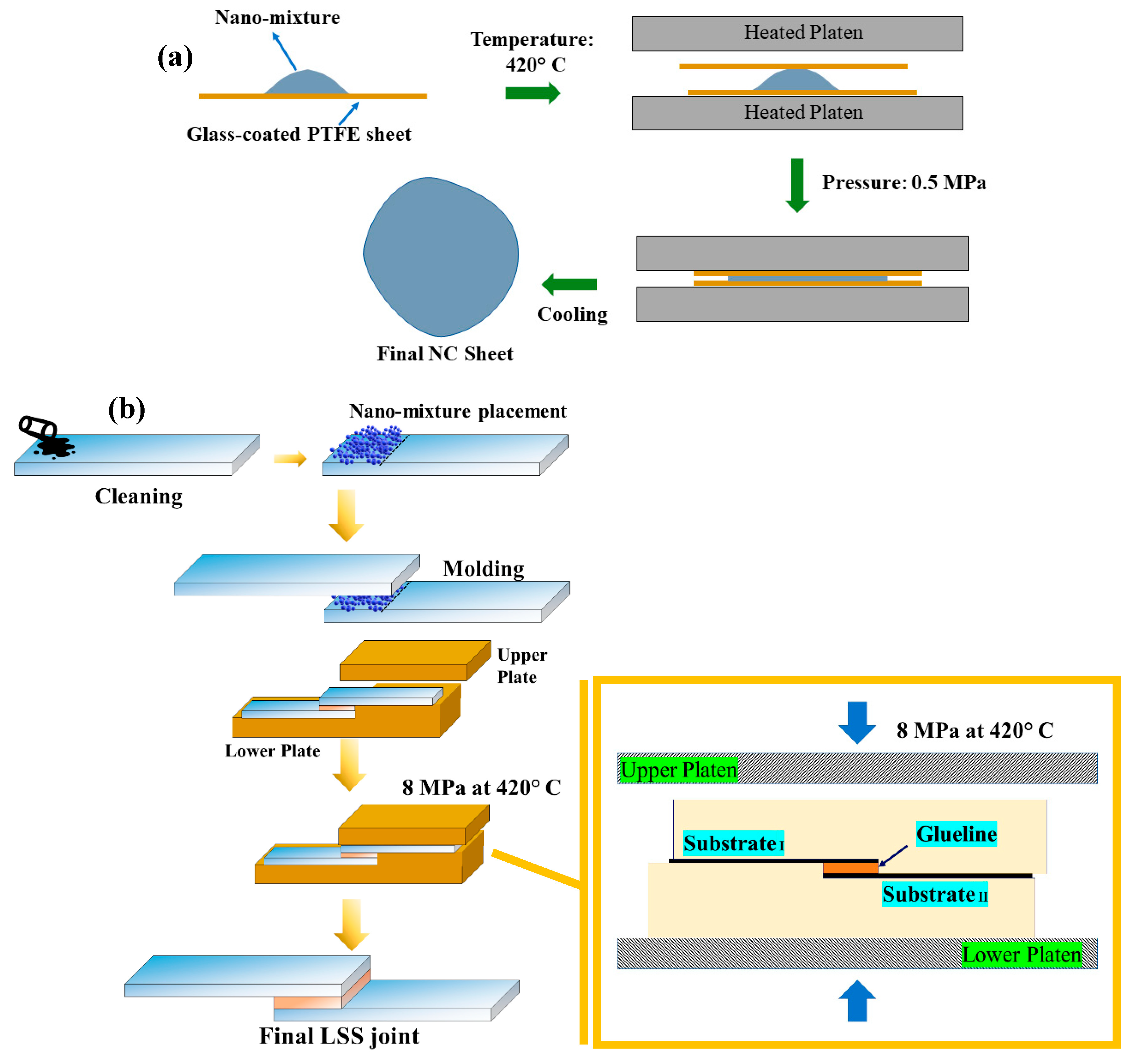
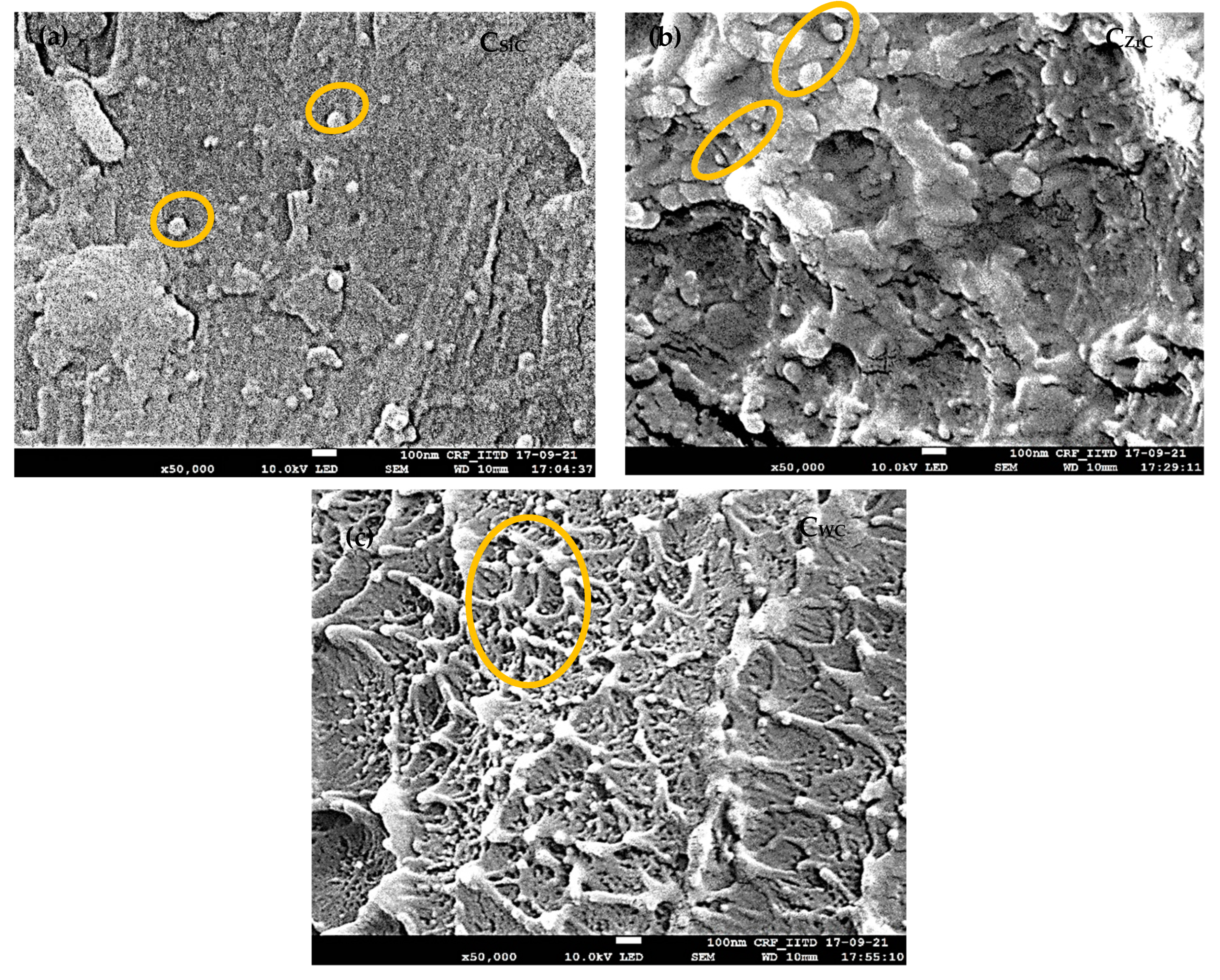
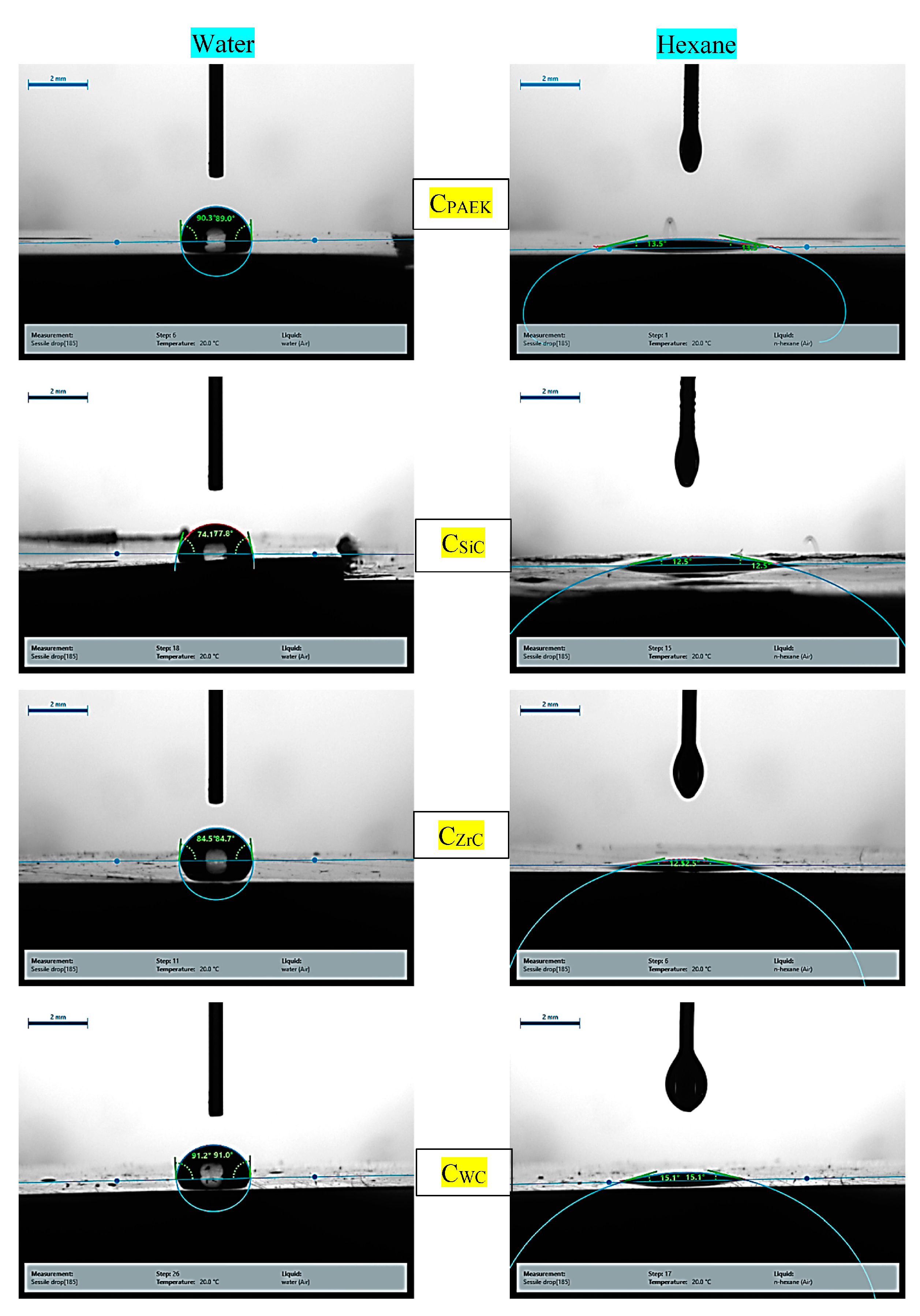
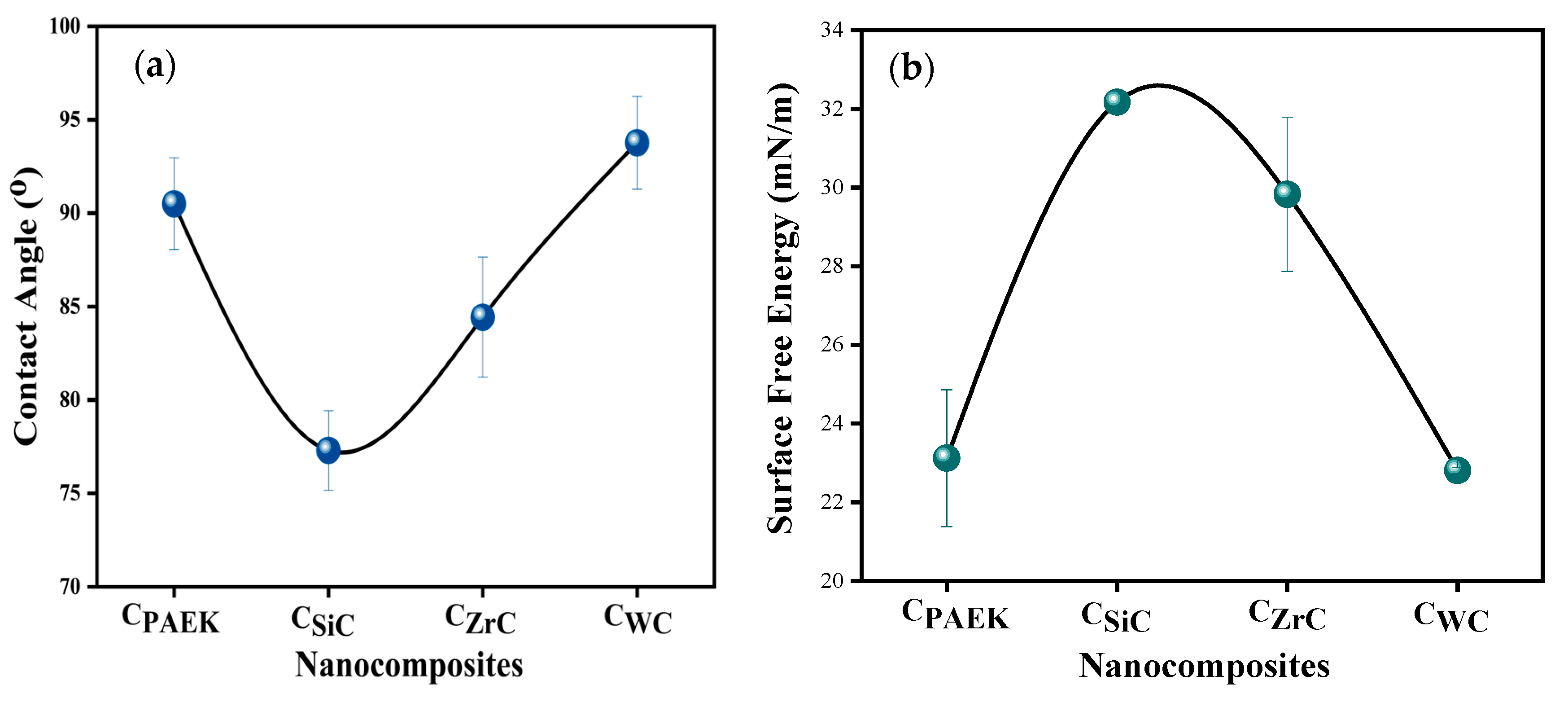
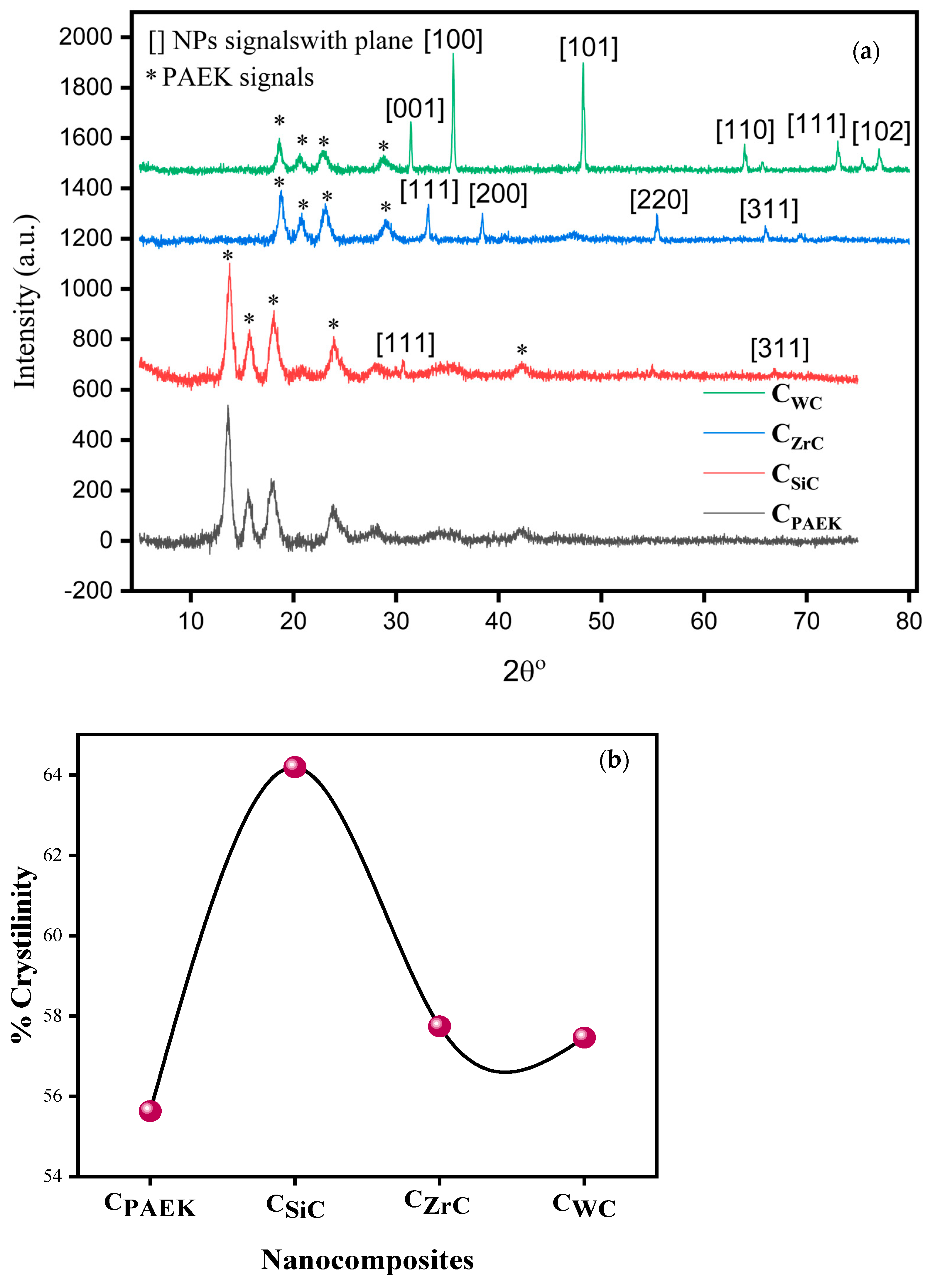
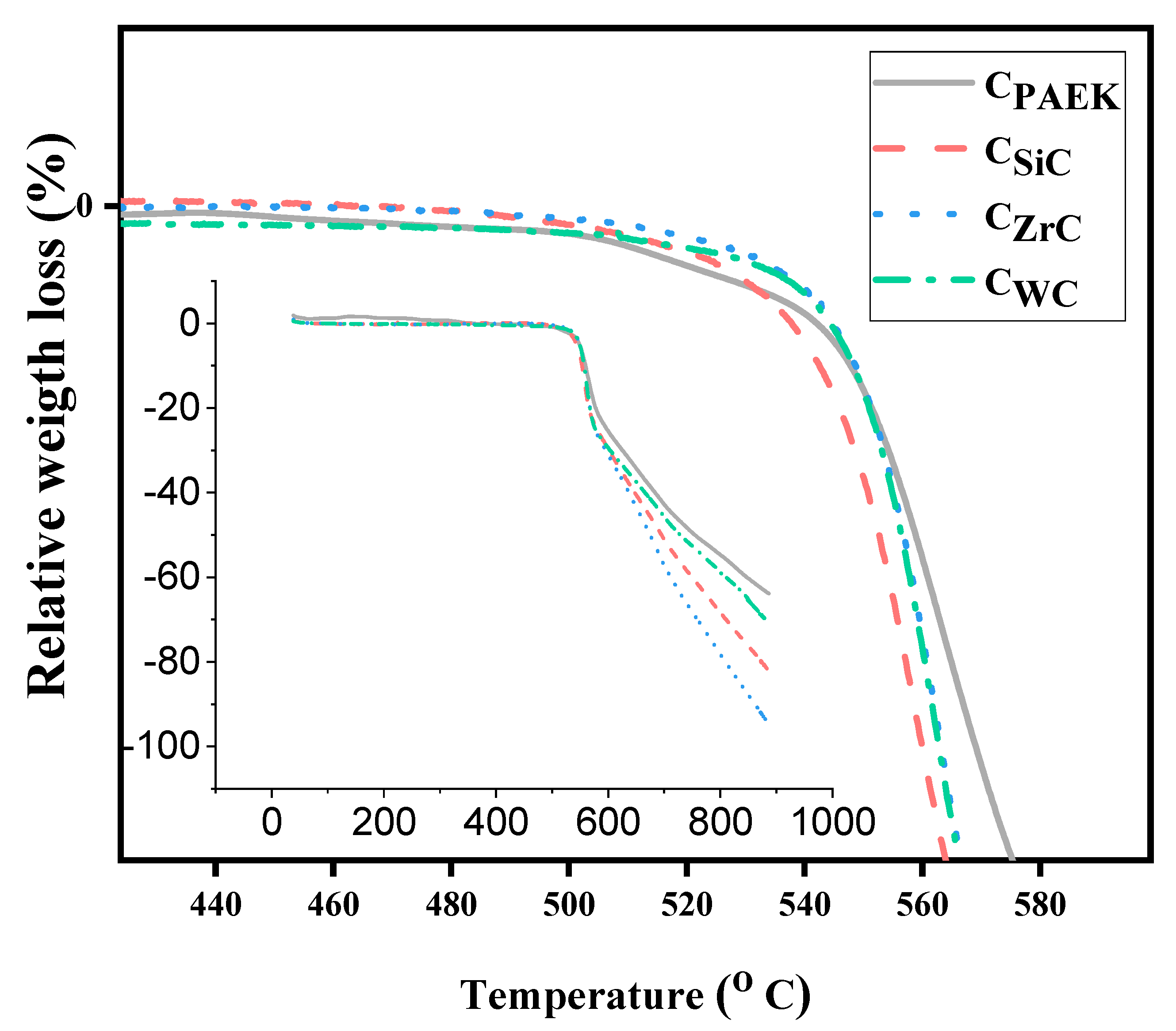
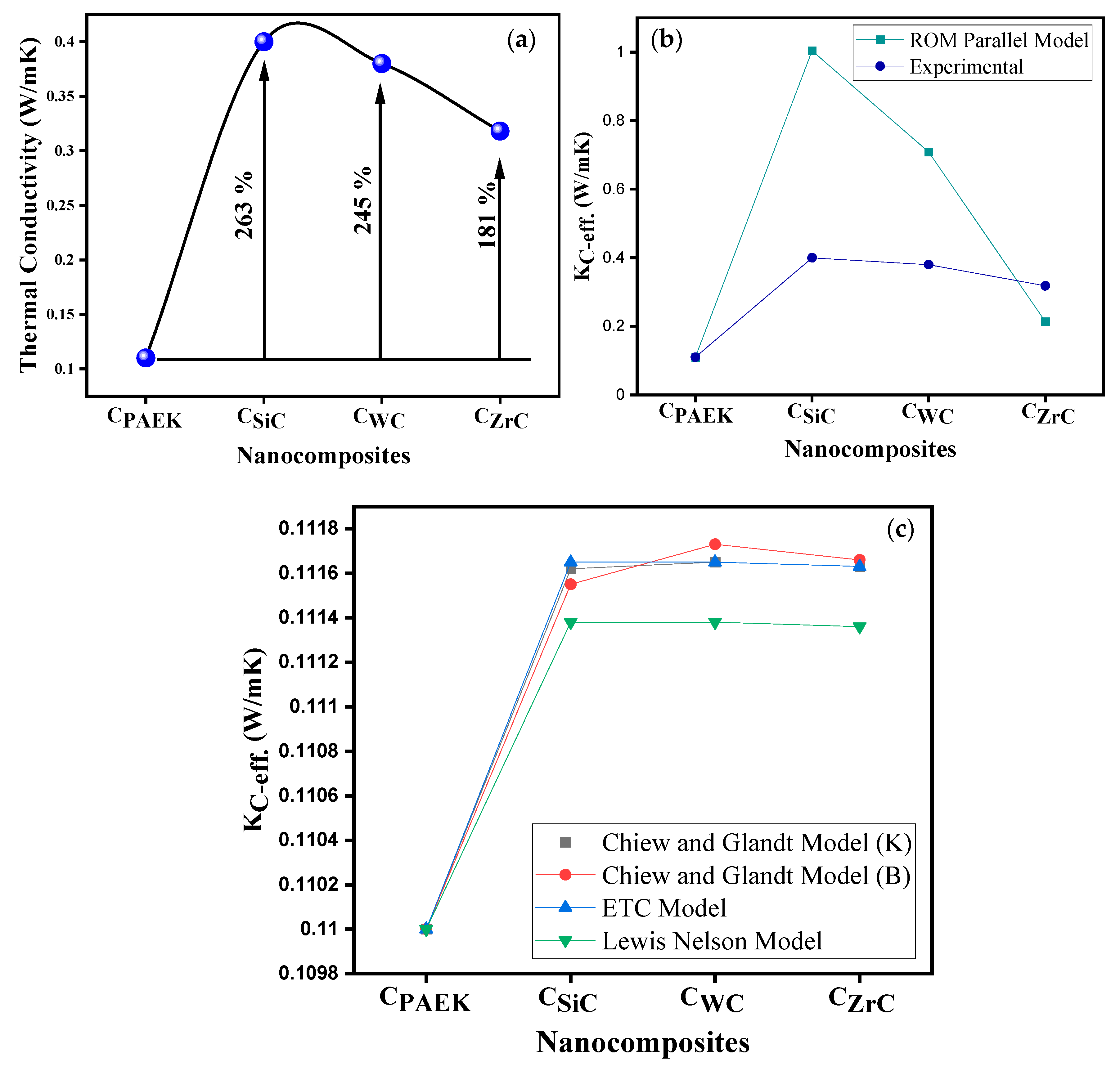
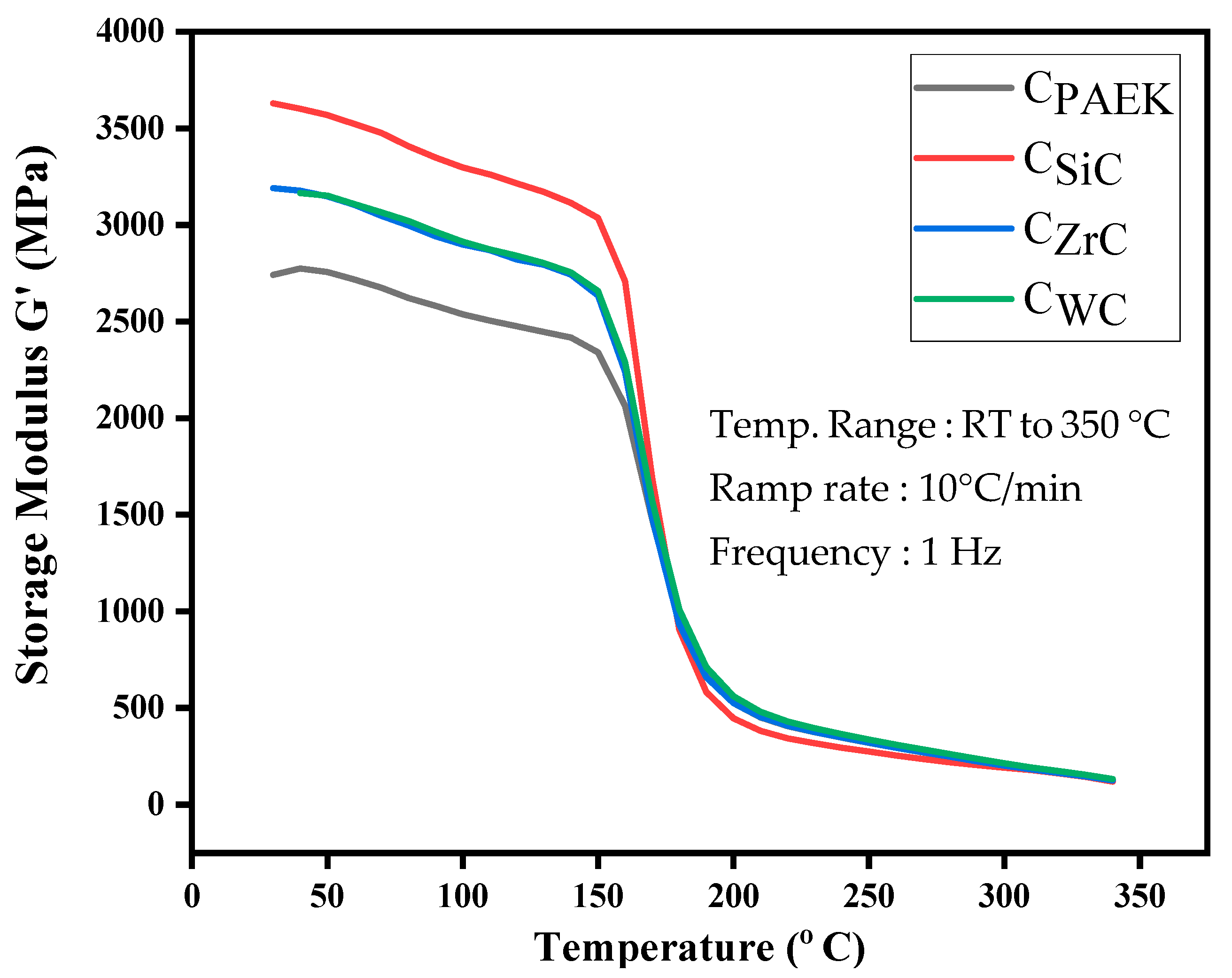

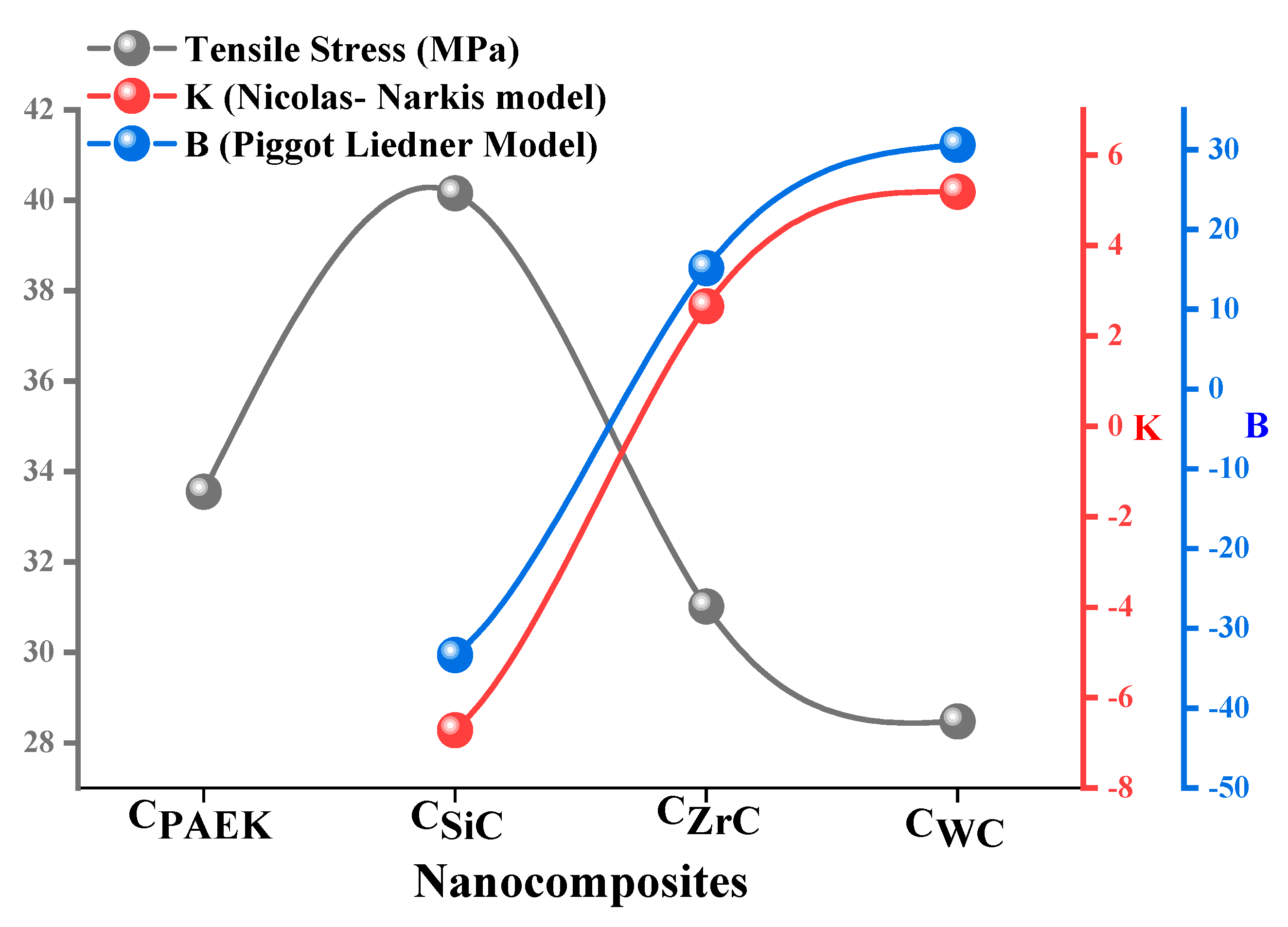
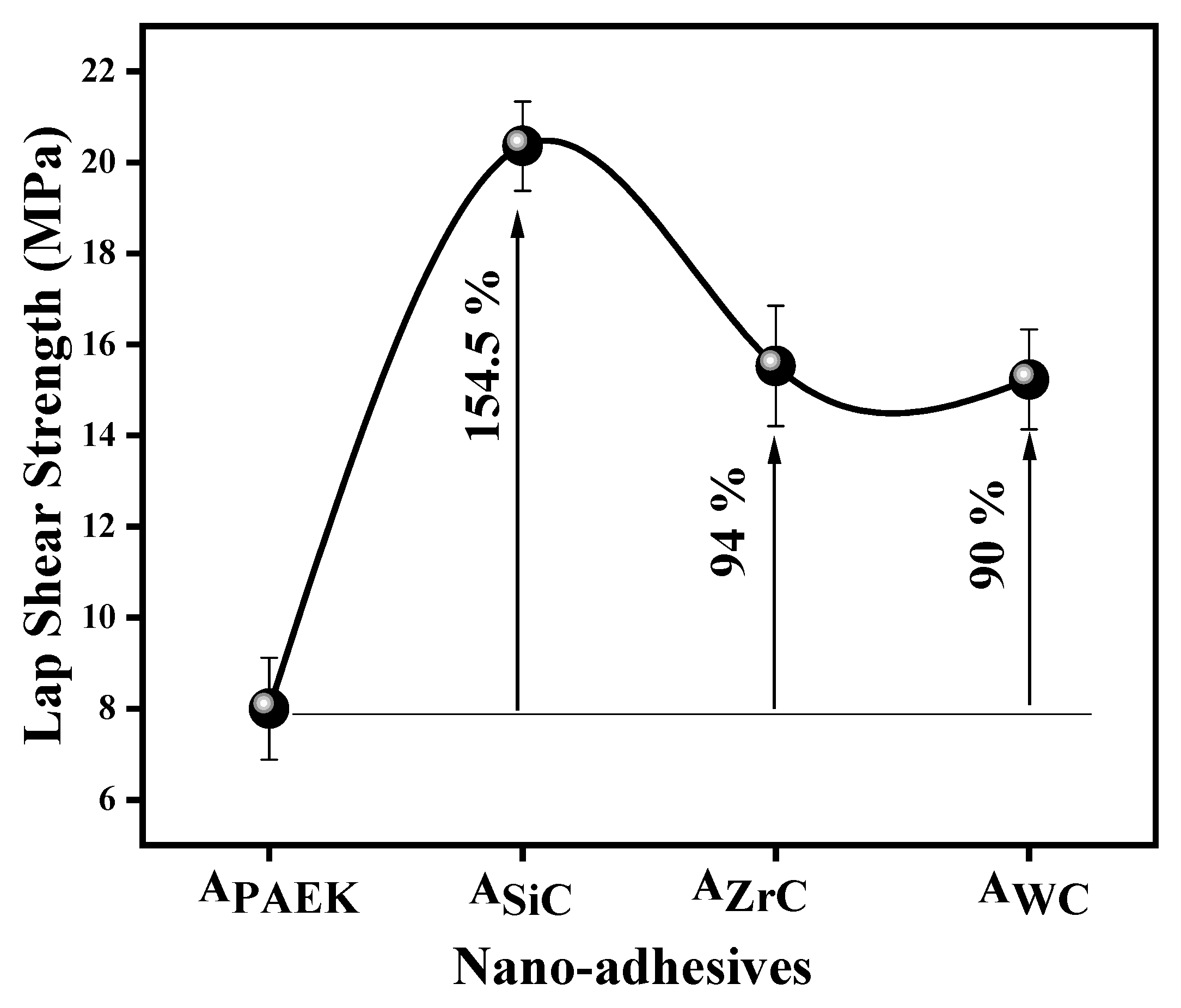
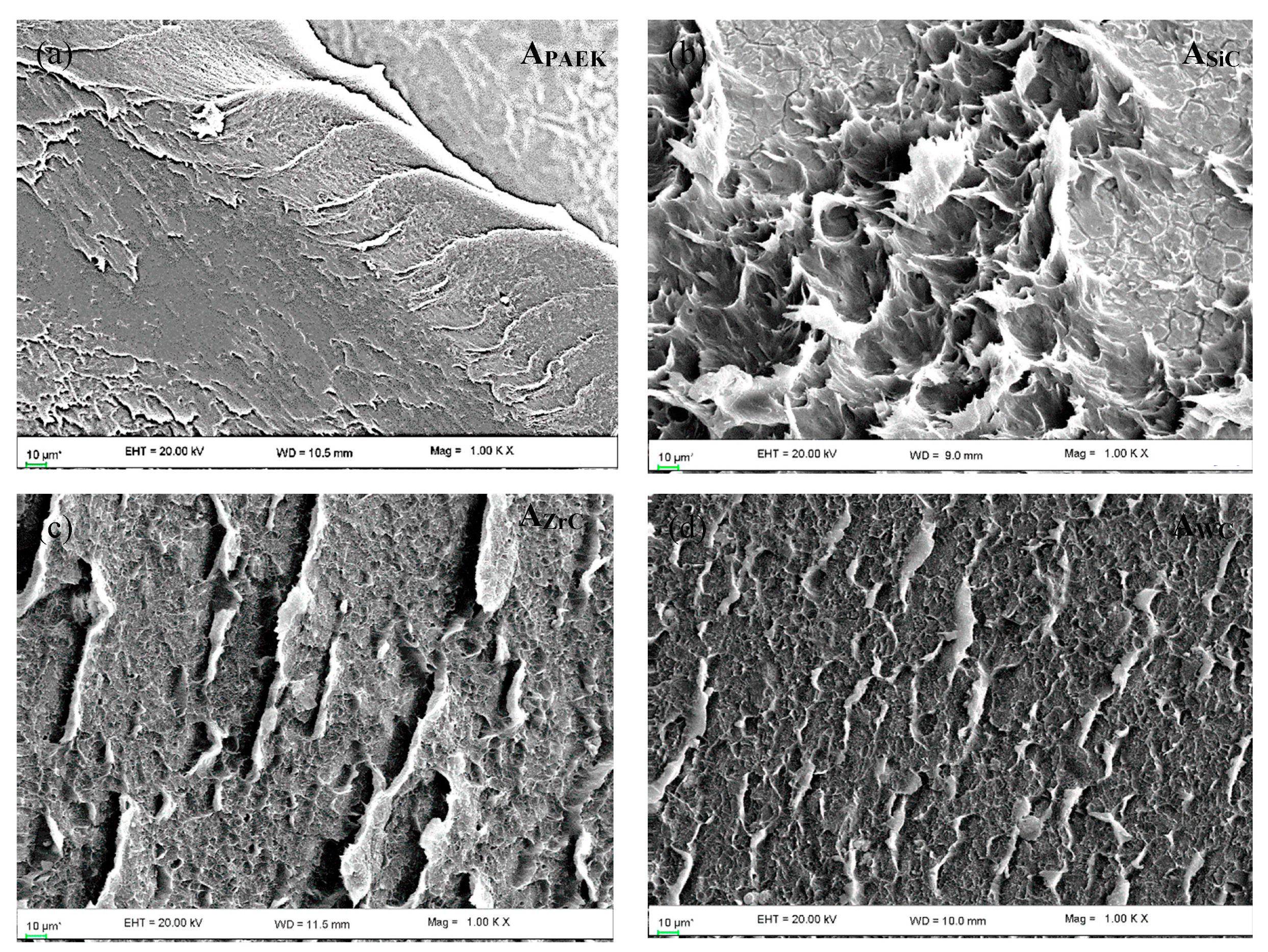
| Properties | SiC | ZrC | WC |
|---|---|---|---|
| Supplier | NanoAmor (Houston, TX, USA) | Nanoshel LLC (Wilmington, NC, USA) | Nanoshel LLC (Wilmington, NC, USA) |
| Purity (%) | 97.5 | 99.9 | 99.9 |
| Density (g/cc) | 3.21 | 6.56 | 15.62 |
| Particle size (nm) | 55 | 80–100 | <100 |
| Surface area (m3/g) | 35–40 | 45 | -- |
| Shape | Nearly spherical | Nearly spherical | Nearly spherical |
| Melting Point (°C) | 2730 | 3400 | 2830 |
| NCs | NAs | Density (g/cc) | Theoretical Density (g/cc) | Composition (vol. %) | |
|---|---|---|---|---|---|
| PAEK | NPs | ||||
| CPAEK | APAEK | 1.28 | 1.30 | 100 | 00 |
| CSiC | ASiC | 1.32 | 1.30 | 99.50 | 0.5 (SiC) |
| CZrC | AZrC | 1.33 | 1.32 | 99.50 | 0.5 (ZrC) |
| CWC | AWC | 1.38 | 1.37 | 99.50 | 0.5 (WC) |
| CPAEK | CSiC | CZrC | CWC | |
|---|---|---|---|---|
| DI Water CA(+- error) | 90.5 (4.08) | 77.3 (3.21) | 84.43 (4.53) | 93.77 (2.48) |
| Hexane CA(+- error) | 13.52 (0.46) | 12.77 (0.63) | 12.82 (1.67) | 15.18 (0.65) |
| SFE in mN/m (+- error) | 23.12 (1.74) | 32.17 (0.3) | 29.83 (1.96) | 22.81 (0.08) |
| D comp. (+- error) | 17.89 (0.03) | 17.94 (0.2) | 17.95 (0.04) | 17.76 (0.005) |
| P comp. (+- error) | 5.23 (3.54) | 14.22 (0.18) | 11.89 (1.92) | 5.04 (0.03) |
| Nanocomposites | CPAEK | CSiC | CZrC | CWC |
|---|---|---|---|---|
| T5 (°C) | 547.9 | 549.3 | 554.6 | 554.6 |
| T10 (°C) | 559.4 | 558.9 | 562.5 | 562.7 |
| NCs | CPAEK | CSiC | CWC | CZrC |
|---|---|---|---|---|
| Storage modulus (MPa) | 2742 | 3630 | 3171 | 3191 |
Disclaimer/Publisher’s Note: The statements, opinions and data contained in all publications are solely those of the individual author(s) and contributor(s) and not of MDPI and/or the editor(s). MDPI and/or the editor(s) disclaim responsibility for any injury to people or property resulting from any ideas, methods, instructions or products referred to in the content. |
© 2023 by the authors. Licensee MDPI, Basel, Switzerland. This article is an open access article distributed under the terms and conditions of the Creative Commons Attribution (CC BY) license (https://creativecommons.org/licenses/by/4.0/).
Share and Cite
Marathe, U.; Bijwe, J. Assimilation of Nanoparticles of SiC, ZrC, and WC with Polyaryletherketone for Performance Augmentation of Adhesives. Nanomaterials 2023, 13, 1028. https://doi.org/10.3390/nano13061028
Marathe U, Bijwe J. Assimilation of Nanoparticles of SiC, ZrC, and WC with Polyaryletherketone for Performance Augmentation of Adhesives. Nanomaterials. 2023; 13(6):1028. https://doi.org/10.3390/nano13061028
Chicago/Turabian StyleMarathe, Umesh, and Jayashree Bijwe. 2023. "Assimilation of Nanoparticles of SiC, ZrC, and WC with Polyaryletherketone for Performance Augmentation of Adhesives" Nanomaterials 13, no. 6: 1028. https://doi.org/10.3390/nano13061028
APA StyleMarathe, U., & Bijwe, J. (2023). Assimilation of Nanoparticles of SiC, ZrC, and WC with Polyaryletherketone for Performance Augmentation of Adhesives. Nanomaterials, 13(6), 1028. https://doi.org/10.3390/nano13061028






